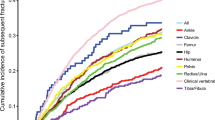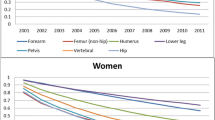Abstract
Summary
We report on second fracture occurrence in the year following a hip, shoulder or wrist fracture using insurance claims. Among 273,330 people, 4.3 % had a second fracture; risk did not differ by first fracture type. Estimated adjusted second fracture probabilities may facilitate population-based evaluation of secondary fracture prevention strategies.
Introduction
The purpose of this study was estimate second fracture risk for the older US population in the year following a hip, shoulder, or wrist fracture.
Methods
Observational cohort study of Medicare fee-for-service beneficiaries with an index hip, shoulder, or wrist fragility fracture in 2009. Time-to-event analyses using Cox proportional hazards models to characterize the relationship between index fracture type (hip, shoulder, wrist) and patient factors (age, gender, and comorbidity) on second fracture risk in the year following the index fracture.
Results
Among 273,330 individuals with fracture, 11,885 (4.3 %) sustained a second hip, shoulder or wrist fracture within one year. Hip fracture was most common, regardless of the index fracture type. Comparing adjusted second fracture risks across index fracture types reveals that the magnitude of second fracture risk within each age-comorbidity group is similar regardless of the index fracture. Men and women face similar risks with frequently overlapping confidence intervals, except among women aged 85 years or older who are at greater risk.
Conclusions
Regardless of index fracture type, second fractures are common in the year following hip, shoulder or wrist fracture. Secondary fracture prevention strategies that take a population perspective should be informed by these estimates which take competing mortality risks into account.



Similar content being viewed by others
References
Dennison E, Cole Z, Cooper C (2005) Diagnosis and epidemiology of osteoporosis. Curr Opin Rheumatol 17(4):456–461
Kanis JA (2002) Diagnosis of osteoporosis and assessment of fracture risk. Lancet 359(9321):1929–1936
Kanis JA, Johnell O, De Laet C et al (2004) A meta-analysis of previous fracture and subsequent fracture risk. Bone 35(2):375–382
Klotzbuecher CM, Ross PD, Landsman PB et al (2000) Patients with prior fractures have an increased risk of future fractures: a summary of the literature and statistical synthesis. J Bone Miner Res Off J Am Soc Bone Miner Res 15(4):721–739
Robinson CM, Royds M, Abraham A et al (2002) Refractures in patients at least forty-five years old. a prospective analysis of twenty-two thousand and sixty patients. J Bone Joint Surg Am Vol 84-A(9):1528–1533
Cooper C, Atkinson EJ, O’Fallon WM et al (1992) Incidence of clinically diagnosed vertebral fractures: a population-based study in Rochester, Minnesota, 1985–1989. J Bone Miner Res Off J Am Soc Bone Miner Res 7(2):221–227
Radley DC, Gottlieb DJ, Fisher ES et al (2008) Comorbidity risk-adjustment strategies are comparable among persons with hip fracture. J Clin Epidemiol 61(6):580–587
Romano PS, Roos LL, Jollis JG (1993) Adapting a clinical comorbidity index for use with ICD-9-CM administrative data: differing perspectives. J Clin Epidemiol 46(10):1075–1079, discussion 81-90
Eisman JA, Bogoch ER, Dell R et al (2012) Making the first fracture the last fracture: ASBMR task force report on secondary fracture prevention. J Bone Miner Res Off J Am Soc Bone Miner Res 27(10):2039–2046
American Orthopaedic Association. Own the Bone. Secondary Own the Bone. http://www.ownthebone.org/about-own-the-bone.aspx
National Committee for Quality Assurance. Osteoporosis testing and management in older women. Secondary osteoporosis testing and management in older women 2014. http://www.ncqa.org/ReportCards/HealthPlans/StateofHealthCareQuality/2014TableofContents/Osteoporosis.aspx
Lee YK, Ha YC, Yoon BH et al (2013) Incidence of second hip fracture and compliant use of bisphosphonate. Osteoporos Int: J Established Result Cooperation Between Eur Foundation Osteoporos Nat Osteoporos Foundation USA 24(7):2099–2104
Melton LJ 3rd, Kearns AE, Atkinson EJ et al (2009) Secular trends in hip fracture incidence and recurrence. Osteoporos Int: J Established Result Cooperation Between Eur Foundation Osteoporos Nat Osteoporos Foundation USA 20(5):687–694
Melton LJ 3rd, Crowson CS, O'Fallon WM (1999) Fracture incidence in Olmsted County, Minnesota: comparison of urban with rural rates and changes in urban rates over time. Osteoporos Int: J Established Result Cooperation Between Eur Foundation Osteoporos Nat Osteoporos Foundation USA 9(1):29–37
Schousboe JT, Taylor BC, Fink HA et al (2007) Cost-effectiveness of bone densitometry followed by treatment of osteoporosis in older men. JAMA: J Am Med Assoc 298(6):629–637. doi:10.1001/jama.298.6.629
Gaines JM, Marx KA, Caudill J et al (2010) Older men’s knowledge of osteoporosis and the prevalence of risk factors. J Clin Densitometry: Off J Int Soc Clin Densitometry 13(2):204–209
Kiebzak GM, Beinart GA, Perser K et al (2002) Undertreatment of osteoporosis in men with hip fracture. Arch Intern Med 162(19):2217–2222
Acknowledgments
This study was supported by a grant from the National Institute of Arthritis and Musculoskeletal and Skin Diseases (#P60 AR062799).
Author information
Authors and Affiliations
Corresponding author
Ethics declarations
Conflicts of interest
The authors declare that they have no conflict of interests.
Electronic supplementary material
Below is the link to the electronic supplementary material.
ESM 1
(DOCX 120 kb)
Supplementary Figure 1
(GIF 52 kb)
Online Supplementary Table 1
(DOCX 31 kb)
Online Supplementary Table 3
(DOCX 39 kb)
Rights and permissions
About this article
Cite this article
Bynum, J.P.W., Bell, JE., Cantu, R.V. et al. Second fractures among older adults in the year following hip, shoulder, or wrist fracture. Osteoporos Int 27, 2207–2215 (2016). https://doi.org/10.1007/s00198-016-3542-6
Received:
Accepted:
Published:
Issue Date:
DOI: https://doi.org/10.1007/s00198-016-3542-6




